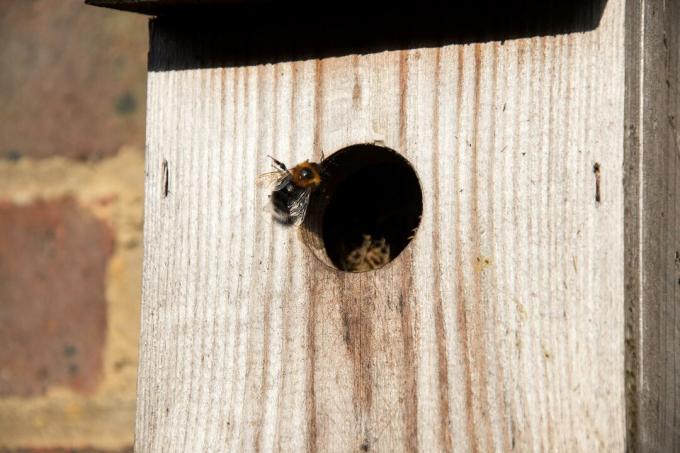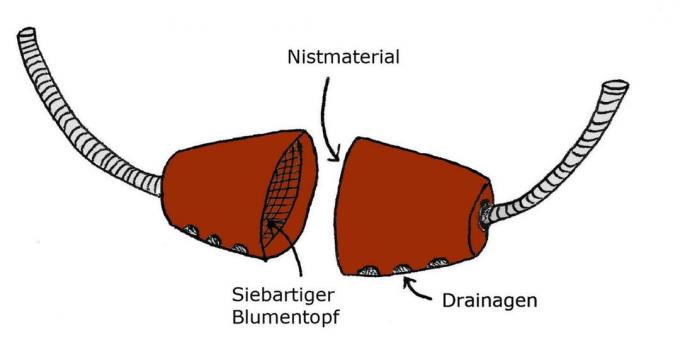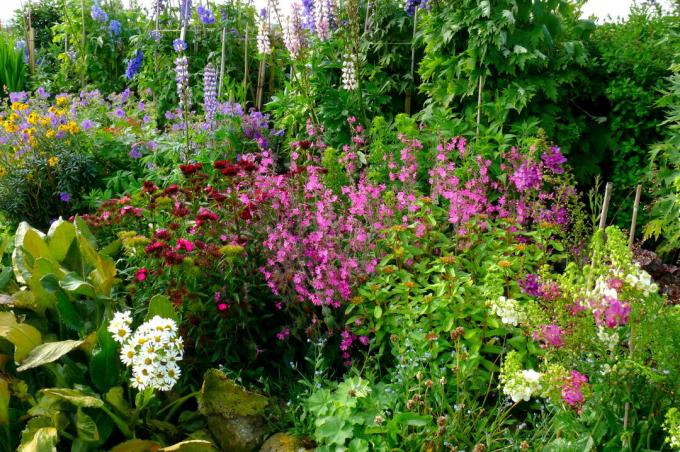Bumblebee nests can often be found on your own property. We show how you can use a nest box to build a safe place for the bumblebees in the garden.

Bumblebees are excellent pollinators, very peaceful and also look nice with their many hairs and beautiful colors. That makes them popular insects in the garden. But unfortunately there are fewer and fewer due to the decline in habitats. Find out here how you can support bumblebees in your garden.
contents
- Recognize bumblebee nests
- Why do bumblebees need a nesting box?
- Buying a bumblebee nest box: what to look out for
-
Build a bumblebee nest box yourself
- Materials needed for a bumblebee nest box
- The right drainage for a bumblebee nest box
- Build the entrance and exit of the nest box
- Put the nesting aid together
- The right place for a bumblebee nest box
- Set up the bumblebee nest box
As soon as it gets a little warmer, the bumblebee queens start looking for a suitable nesting place to build a colony. Since bumblebees can fly just above 0 ° C even at very low temperatures, they look around carefully for a nesting opportunity as early as March. So now is the right time to set up a bumblebee nest box.
Recognize bumblebee nests
Bumblebees nest in a wide variety of places, either above or below ground, the main thing is that they are well protected. The demands are different depending on the species. Earth bumblebees nest, as their name suggests, underground in abandoned mouse holes and the like, while tree bumblebees like hollow trees and stone bumblebees like to choose the underside of stones. Species such as the field bumblebee and the meadow bumblebee are less picky, and the stone bumblebee can also be carried away to places other than stones.

If you want to find a bumblebee nest, there are therefore many options. Holes in the ground or abandoned bird nesting boxes are preferred places. Once you have found a bumblebee nest, you will recognize spherical honeycombs in which the young bumblebees are raised and nectar and pollen are collected. Bumblebee nests that are still inhabited are also constantly occupied by the so-called stick bees, who take care of the brood. Bumblebee nests must not be removed as they are strictly protected. If the nest is in a disturbing place, you only have to be patient for one summer, because the bumblebee queen spends the winter in a different place.
Why do bumblebees need a nesting box?
The number and variety of bumblebees in Germany continues to decline. There are various reasons for this. Probably the most important reason is the decline in flowering plants in our landscape. On the one hand, this concerns the agricultural cultural landscape, in which field margins and flowering meadows are hardly present any more. On the other hand, gardens are also often affected. Where there used to be flowering meadows and colorful plants, today there are often stone areas or lawns mown every week. For more insect-friendly plants, use a seed mix like this Plantura bee pasture which is also ideal for bumblebees. It contains a wide variety of flowers and herbs that provide bumblebees and bees with nectar and pollen.
If flowering plants are available, however, there is often a lack of suitable nesting sites. For this reason, nesting aids for bumblebees can be very useful. In order for these to be colonized, however, you should also pay attention to a good environment. Bumblebees will only actually settle where flowering plants are found nearby as a source of food.

Buying a bumblebee nest box: what to look out for
Buying a bumblebee nest box is not as easy as expected, because not every nest box that is on the market is actually suitable. In order to create the same conditions that bumblebees find in their natural breeding places in holes in the ground and tree hollows, a few things have to be taken into account.
On the one hand, you have to decide whether you prefer an aboveground or underground bumblebee nest house. Both are possible, but of course they attract different species of bumblebee. While tree bumblebees like to nest above ground, bumblebees prefer to stay underground. Both types should be built so that no water can run into them. Moisture problems can quickly arise, especially with underground nesting houses. Above-ground houses are mainly affected by overheating, depending on the material. Both of these lead to the death of the bumblebee colony and should therefore be avoided at all costs. Protection against wax moths, which can destroy entire nests, is also useful. This is guaranteed by a bumblebee flap and protected ventilation holes.

The long-lasting, Above-ground nesting box from Hummeltischler or Schwegler's nest box for bumblebees nesting underground. An extensive and growing list of Bumblebee nest boxes in a practical test can be found at pollen panties.
Build a bumblebee nest box yourself
For hobby craftsmen, building a bumblebee nest box is of course a special pleasure, even more so with children. An easy to replicate and inexpensive nesting aid for bumblebees is described below:
Materials needed for a bumblebee nest box
For the nest box:
- Two flower pots of the same size
- Two sieve-like, somewhat smaller flower pots
- Two flexible plastic tubes (diameter approx. 2 cm), slightly fluted
- cable ties
- Old sheer tights
- Duct tape
For the nesting material:
- Fine straw or hay
- Dry moss
- Animal hair
The right drainage for a bumblebee nest box
Cut three holes of roughly the same size in the bottom of the two large flower pots. These serve as drainage in case water should penetrate the bumblebee house. To prevent ants or insects from getting in, tape up these holes from the outside with pieces of the pantyhose so that they form a grid in front of the openings.
Then put the two smaller, sieve-like pots in one of the two larger ones. These two inner lattice pots are used to ensure that water that penetrates the inside of the outer pot can drain off to the drainage holes without soaking the bumblebee's nest.
Build the entrance and exit of the nest box
Insert a plastic tube into each of the two pot combinations through the hole in the bottom of the pot. The two pipes serve as the entrance and exit for the bumblebee nest house. If there is no hole in the pots, you can of course cut it into it. Then seal the transition point on the outside with sturdy adhesive tape, such as duct tape, watertight. Use corrugated pipes so that the bumblebees can crawl in them and are not trapped in the house.

Put the nesting aid together
Now fill one of the two halves of the nesting aid loosely with the nesting material. To do this, mix dry moss, fine straw or hay and, if necessary, animal hair, like that of a dog. Now the nesting house only has to be assembled: Connect the two inner small pots firmly with cable ties so that there is no gap. It would be fatal for a bumblebee to get lost between the inner and outer pot. Now glue the two outer pots together watertight with adhesive tape. The Hummelhaus is ready.
The right place for a bumblebee nest box
Now the bumblebee house only has to be set up. Since it is an underground bumblebee nesting house, choose a location where water does not build up during torrential rain. Then bury it briefly under the surface of the earth, bending the pipes so that a bumblebee can crawl into them comfortably. You can drape some moss and stones around the entrance to protect it and make it more welcoming.

Pronounced hobby craftsmen may not do justice to these instructions. If you want to build a more elaborate bumblebee nest box, you may find it at the Building introduction for a bumblebee nest box According to Jörg Börner, you will find what you are looking for.
Set up the bumblebee nest box
The most beautiful house is of no use if there is no food. Of course, this also applies to bumblebees. Nest boxes, regardless of the variety, should therefore be close to flowering plants that serve as a source of food. Furthermore, the place should be well protected. Underground nesting boxes are particularly threatened by moisture and mold, and above-ground nesting boxes can overheat.

Therefore, choose a shady location that is protected from heavy rain - it would be ideal under a light bush or something similar. The place should of course be quiet and, for example, not directly on a passageway. A corner of the garden that can be a little wilder would be ideal. With above-ground nesting boxes, you should ensure that they are stable. The entrance and exit should face away from the weather.
You haven't had enough of the subject Bumblebees? In our special article we answer the most frequently asked questions about the little striped garden dwellers.
